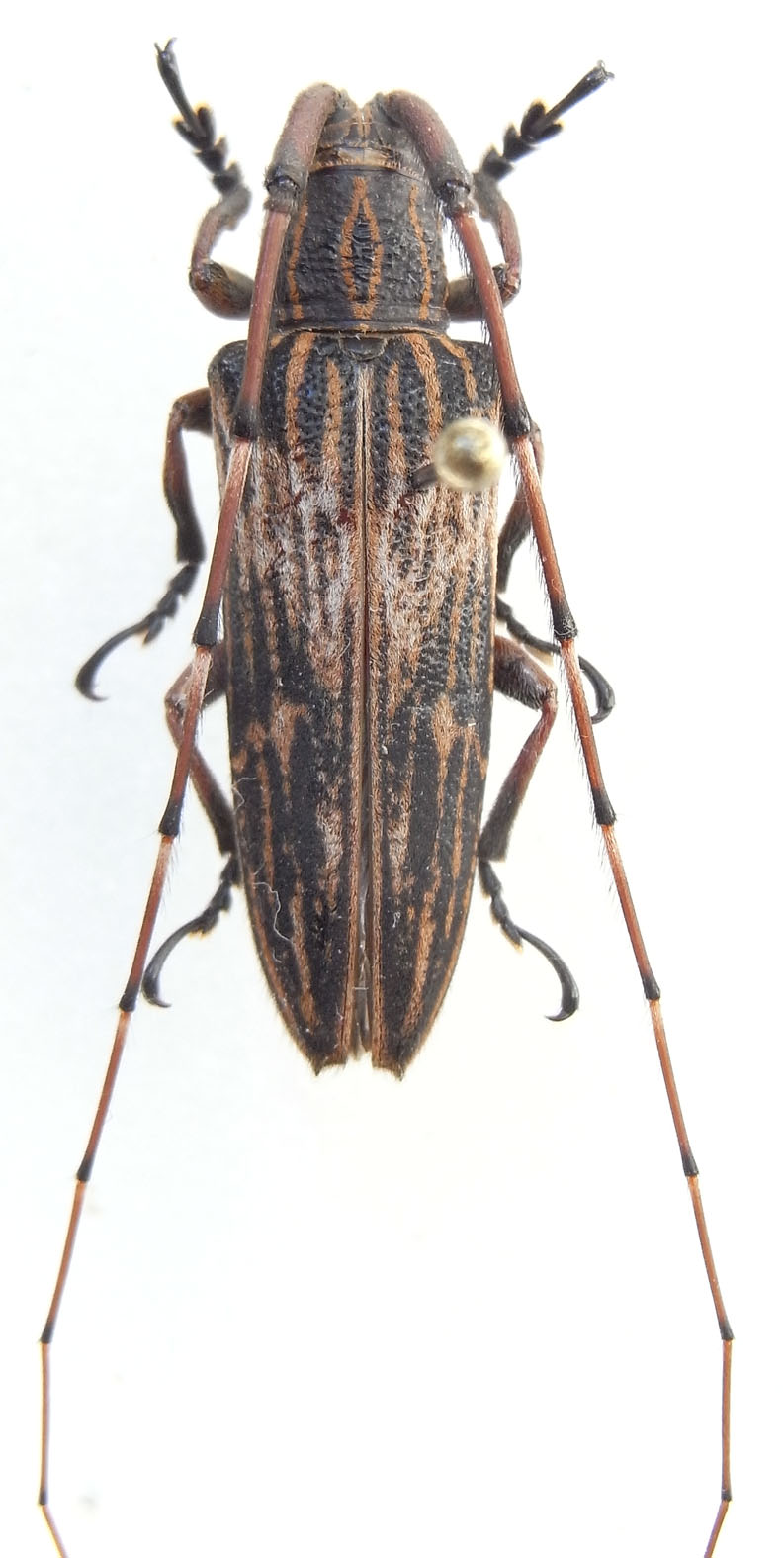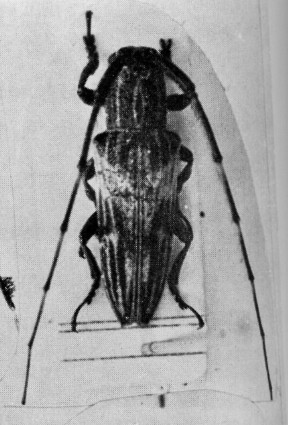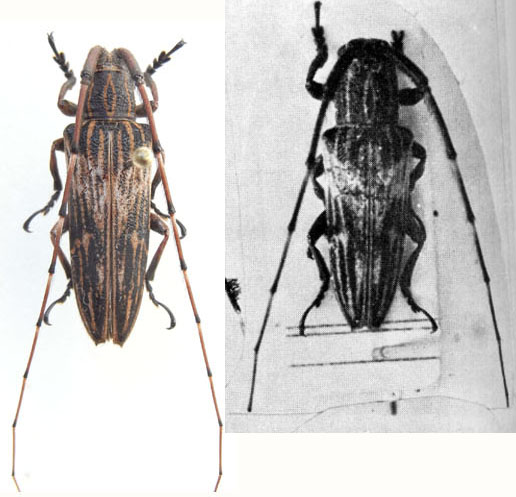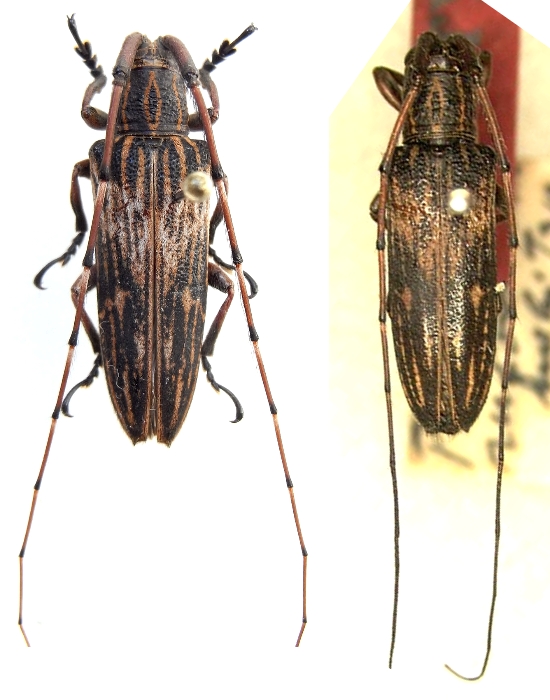| Author |
 Topic Topic  |
|
Xavier
Scientific Collaborator
    
France
12338 Posts |
 Posted - 14/08/2012 : 11:20:05 Posted - 14/08/2012 : 11:20:05



|

21 mm. Hua Phan, nord Laos.
Une Phelipara aux tibias antérieurs échancrés, 8 bandes sur le pronotum (en en comptant 2 au milieu du pronotum !).
Le 3ème article antennaire plus long que le scape m'oriente vers Phelipara laosensis Breuning, 1964. Mais la dimension donnée par Breuning, 14 mm, ne colle pas ( mais sur un seul exemplaire !).
Une ressemblance avec Phelipara marmorata Pascoe, 1866, mais les bandes du pronotum me semblent différentes... |
|
|
Petr Viktora
Member Nathrius
Czech Republic
28 Posts |
 Posted - 13/09/2012 : 19:25:04 Posted - 13/09/2012 : 19:25:04



|
| Pothyne rufovittata Breuning, 1943 |
 |
|
|
Xavier
Scientific Collaborator
    
France
12338 Posts |
 Posted - 13/09/2012 : 20:00:09 Posted - 13/09/2012 : 20:00:09



|
Thanks a lot !
I would never have looked in this genus !! |
 |
|
|
Bi
Member Demonax

China
59 Posts |
 Posted - 15/09/2012 : 06:41:38 Posted - 15/09/2012 : 06:41:38



|

I have different views about this species, I mentioned here early this year.
"BTW: the same book (Longicornes du Loas, 1970), there appeared a unmarked specimen at the upper right corner on fig.14. I noticed it for a long time."
Now, I consider it as Paranandra sp. cf. laosensis Breuning, 1942.
And maybe the same species Xavier posted. |
 |
|
|
Xavier
Scientific Collaborator
    
France
12338 Posts |
 Posted - 15/09/2012 : 09:36:44 Posted - 15/09/2012 : 09:36:44



|
Hi,
Sorry, but I don't understand. In Gressitt (1970), the picture "d", figure 14 is discribed as Phelipara (s.st.) marmorata (page 373 and page 374). The problem is may be the size : 13 to 18 mm . My question is : why it couln't be a Phelipara as I said in first ? |
 |
|
|
Xavier
Scientific Collaborator
    
France
12338 Posts |
 Posted - 15/09/2012 : 09:53:26 Posted - 15/09/2012 : 09:53:26



|

Just to compare... It's exactely the same species, as said Insectb . |
 |
|
|
Petr Viktora
Member Nathrius
Czech Republic
28 Posts |
 Posted - 15/09/2012 : 11:12:47 Posted - 15/09/2012 : 11:12:47



|
HOLOTYPE of Pothyne rufovittata Breuning,
In Rondon et Breuning, 1970 are errors in the photos (and elsewhere) |
 |
|
|
Xavier
Scientific Collaborator
    
France
12338 Posts |
 Posted - 15/09/2012 : 11:40:57 Posted - 15/09/2012 : 11:40:57



|
| After seeing the type, it "seems" clear ! Well done ! |
 |
|
|
Bi
Member Demonax

China
59 Posts |
 Posted - 15/09/2012 : 19:30:13 Posted - 15/09/2012 : 19:30:13



|
| Thanks Petr! |
 |
|
|
Francesco
Forum Admin
    
Luxembourg
9511 Posts |
 Posted - 18/09/2012 : 22:52:21 Posted - 18/09/2012 : 22:52:21




|
This species gives me many doubts.
First of all, it does not belong to the genus Pothyne, which all have more delicate habitus, parallel-sided elytra, scarcely elevated antennal supports, and feebly reclined head (there are several species in the Forum).
If we use Breuning's keys (1966 and 1970), the doubt may be between Phelipara and Paranandra.
Later, if Paranandra laosensis Breuning, 1942, Phelipara submarmorata Breuning, 1960 and Pothyne rufovittata Breuning, 1960 are (all or partially) actually the same species, this is another serious doubt... |
 |
|
|
Xavier
Scientific Collaborator
    
France
12338 Posts |
 Posted - 18/09/2012 : 22:58:29 Posted - 18/09/2012 : 22:58:29



|
I share your doubt : it's doesn't looks like a Pothyne species.
But after seeing the type specimen, I don't know what thinking. What another mystery ! |
 |
|
|
Francesco
Forum Admin
    
Luxembourg
9511 Posts |
 Posted - 18/09/2012 : 23:15:39 Posted - 18/09/2012 : 23:15:39




|

Actually, I am not sure that these are actually the same species. There are some differences:
The antennae are bicolour in your specimen, while they apically black starting from the antennomere VII in the type.
The elytral shape is more apically convergent in your specimen, while it is nearly parallel in the type (similar to Pothyne?)
The elytral pattern is analogue, but the orange one is more defined and developed in your specimen.
And... dulcis in fundo... the original description of P. rufovittata does not mention any transversal white, whitish or light band! |
 |
|
|
Xavier
Scientific Collaborator
    
France
12338 Posts |
 Posted - 19/09/2012 : 08:30:18 Posted - 19/09/2012 : 08:30:18



|
Well, for me these differences are very light on picture. The type has 60 years old and could be geasy, but habitus and patterns are so close...The main problem at all is not about same or different species . We can think that Breuning has made a mistake about the genus of this species, and to prove that, it's necessary to examin the holotype !
After that, it could be easy to say if my specimen is the same or not species. So, the question is : how find the type ? |
 |
|
|
Petr Viktora
Member Nathrius
Czech Republic
28 Posts |
 Posted - 19/09/2012 : 15:46:16 Posted - 19/09/2012 : 15:46:16



|
I do not see where you're looking for a problem.
Phelipara submarmorata and Pothyne rufovittata are not the same.
Phelipara submarmorata is correctly determined elsewhere in this forum.
I repeat, in image boards (Rondon and Breuning, 1971) are errors.
I am also of the opinion that it is not a genus Pothyne but Phelipara, it is another thing. |
 |
|
|
Xavier
Scientific Collaborator
    
France
12338 Posts |
 Posted - 19/09/2012 : 16:17:21 Posted - 19/09/2012 : 16:17:21



|
Well, it's not easy in english. I have never spoken about Phelipara submarmorata.
One thing is the mistake of picture in Gressitt's book, but in the other hand, there is also the mistake about the holotype of Pothyne rufovittata in Smithsonian.
OR, do you think that this holotype is a "good" Pothyne rufovittata ??? |
 |
|
|
Petr Viktora
Member Nathrius
Czech Republic
28 Posts |
 Posted - 19/09/2012 : 16:37:58 Posted - 19/09/2012 : 16:37:58



|
I responded to the above sentence
"Later, if Paranandra laosensis Breuning, 1942, Phelipara submarmorata Breuning, 1960 and Pothyne rufovittata Breuning, 1960 are (all or partially) actually the same species, this is another serious doubt..."
I have no reason to think that the type of Pothyne rufovittata is bad.
I'm interested in other groups of Cerambycidae, it's just my opinion. |
 |
|
 Topic Topic  |
|


